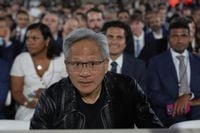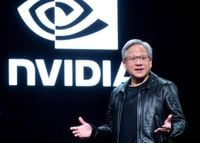During a pivotal visit to Taiwan on August 22, 2025, Nvidia CEO Jensen Huang revealed that the chip giant is in active talks with the Trump administration about developing a new semiconductor chip, potentially named the B30A, tailored specifically for the Chinese market. This move comes as both the U.S. and China continue to navigate a complex landscape of trade restrictions, national security concerns, and technological rivalry, with the semiconductor industry caught squarely in the middle.
Huang’s trip to Taiwan, where he met with executives at Taiwan Semiconductor Manufacturing Corp. (TSMC)—Nvidia’s crucial manufacturing partner and the world’s largest chip maker—underscored the high stakes. Responding to questions about the rumored B30A chip, Huang explained, “I’m offering a new product to China for ... AI data centers, the follow-on to H20. But that’s not our decision to make. It’s up to, of course, the United States government. And we’re in dialogue with them, but it’s too soon to know,” as reported by AP and Yahoo Finance.
The B30A, according to details shared by Fortune and Economic Times, would be based on Nvidia’s advanced Blackwell technology, but it is expected to operate at about half the speed of the company’s flagship B300 chips. This deliberate scaling-down is no accident: top-end Nvidia processors remain barred from China under strict U.S. export controls, which aim to prevent Beijing from acquiring cutting-edge computing power that could be used for military or advanced artificial intelligence (AI) applications.
The backdrop to these negotiations is a recent, and somewhat surprising, thaw in U.S.-China technology trade. After initially banning the sale of Nvidia’s H20 chips to China in April 2025—a product already designed to comply with earlier U.S. restrictions—the Trump administration reversed course following direct lobbying from Huang. The administration approved renewed H20 shipments to China, but with a catch: Nvidia must pay a 15% tax on all such sales to the U.S. government, a policy also applied to rival Advanced Micro Devices (AMD) for its MI380 chips. “The company said it would begin making shipments in July,” reported Yahoo Finance.
Huang, when pressed about the impact of the new tax, sidestepped direct commentary but made clear that Nvidia values the opportunity to serve the Chinese market. “We have made very clear and put to rest that H20 has no security backdoors. There are no such things. There never has. And so hopefully the response that we’ve given to the Chinese government will be sufficient,” he said, as reported by AP and Economic Times.
Security, however, remains a thorny issue. China’s Cyberspace Administration recently posted a public notice alleging that Nvidia’s chips contain “mature tracking and location and remote shutdown technologies,” raising the specter of backdoor vulnerabilities. The agency cited unnamed U.S. AI experts and demanded that Nvidia clarify these claims and provide detailed documentation. Huang expressed surprise at the accusations: “As you know, they requested and urged us to secure licenses for the H20s for some time. And I’ve worked quite hard to help them secure the licenses. And so hopefully this will be resolved,” he told AP. Nvidia is currently engaged in ongoing talks with Chinese regulators to address these concerns and reassure authorities about the integrity of its products.
The broader context is one of shifting, but still fraught, U.S.-China trade relations. As part of recent negotiations, China granted additional permits for exports of rare earth magnets to the U.S.—critical materials for electronics manufacturing—while Washington eased restrictions on chip design software and jet engines. These reciprocal moves have provided companies like Nvidia with a narrow window to maintain business ties with China, even as geopolitical tensions simmer.
Yet, the U.S. government has not been shy about its broader strategy. U.S. Commerce Secretary Howard Lutnick summed up Washington’s approach in a blunt assessment on CNBC: “We don’t sell them our best stuff. Not our second best stuff. Not even our third best, but I think fourth best is where we’ve come out that we’re cool.” This policy is designed to keep China reliant on American technology while limiting its access to the most advanced chips.
For Nvidia, the stakes are enormous. China, including Hong Kong, accounted for $17.1 billion of Nvidia’s $130.4 billion in revenue in its most recent fiscal year, while the U.S. market brought in $61.2 billion, according to Yahoo Finance. Nvidia’s stock has reflected investor confidence in the company’s ability to navigate these choppy waters, with shares up 29.4% year-to-date and 40.5% over the last twelve months. Still, the news of potential new China-specific chips left the stock flat, perhaps signaling investor caution about the regulatory and political risks ahead.
Meanwhile, China’s ruling Communist Party has doubled down on its drive for technological self-reliance, pouring resources into domestic semiconductor development. Companies like Huawei have made significant strides in AI-optimized chips. However, despite these efforts, China remains heavily dependent on foreign semiconductor know-how and manufacturing expertise, a reality that continues to shape the country’s approach to technology policy and trade negotiations.
Nvidia’s current approach reflects a delicate balancing act: it must comply with evolving U.S. export controls, reassure both Washington and Beijing about the security and integrity of its products, and sustain its relevance in the world’s second-largest economy. The company’s efforts to create a less powerful, but still valuable, AI chip for China—the B30A—are emblematic of the broader challenges facing the global tech industry as it is squeezed between superpower rivalries and market realities.
Looking ahead, all eyes will be on Nvidia’s next earnings report, scheduled for release after the market closes on August 27, 2025. Analysts and industry watchers will be keen to see how the company’s China strategy plays out in its financials, and whether ongoing regulatory negotiations will open or close the door to future growth in the region.
The story of Nvidia’s B30A chip talks is, in many ways, a microcosm of the global semiconductor saga—a high-stakes, high-tech tug-of-war with consequences that reach far beyond the boardrooms of Silicon Valley and the halls of government in Washington and Beijing.



